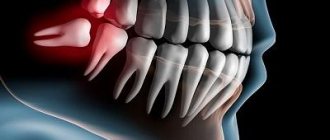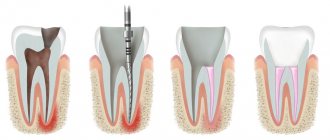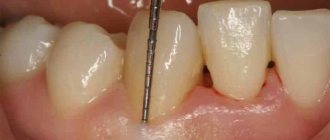What is bifurcation
The bifurcation of a tooth is the area on the tooth itself where the branching of its roots begins (you can see what it looks like in the photo below). The term "bifurcation" means "branching into two", i.e. for two roots. But some teeth have not two, but three roots - in this situation the term “trifurcation” would be more correct, but doctors often still use the word “bifurcation” as a more common concept. Moreover, bifurcation does not occur on any tooth, but on multi-rooted ones - molars have two or more roots (“sixes”, “sevens” and “eights”).
Is it necessary to treat bifurcation?
In fact, when a dentist talks about tooth bifurcation, he means not only the area of root branching itself, but also the pathological processes occurring here. But there should be a clarification here. For example, perforation in the bifurcation area - i.e. the formation of a hole that violates the integrity of the tooth. This pathology not only causes complications (pulpitis, inflammation of the bone socket, etc.), but often calls into question the very existence of the tooth. Therefore, treatment of perforation or other pathologies in the area of root branching should begin as early as possible.
On a note! If there is perforation in the bifurcation area, the tooth is quite difficult to treat and will not last more than 3-5 years, after which it will have to be removed. Such a tooth is not suitable for a prosthesis, since it can no longer withstand increased chewing loads.
General information
In dentistry, bifurcation refers not only to the area of root branching, but also to the pathological processes occurring in this area. Thus, perforation in the bifurcation zone is fraught not only with pulpitis, inflammation of the bone socket, etc., but also with extraction of the unit.
Treatment of perforation and other pathologies in the furcation zone should be carried out in the early stages of problems. This is due to the complexity of measures that extend the service life of the unit to 3–5 years. Installing a prosthesis on a tooth that is perforated in the bifurcation zone is not advisable, since it is not able to withstand excessive chewing loads.
Why problems arise
Involvement of the furcation area in the pathological process occurs in two cases:
- infection penetrates from the outside (through the gum or bone): normally, the furcation area is in close contact with the periodontium and the bone walls of the tooth socket. But if the bone begins to sag (which happens with periodontitis, periodontal disease), then the furcation area becomes accessible to microbes from the external environment. Also, inflammation of the bone (for example, when an infection enters it through the bloodstream) leads to the “melting” of dental tissue. Over time, the root cement is destroyed, a hole appears in the tooth, and microbes penetrate into the pulp,
- from inside the tooth: for example, with pulpitis or perforation of the bottom of the pulp chamber (during drilling or passage of root canals), which is located just above the furcation area. In this case, microbes from the oral cavity penetrate into the bone socket, causing its inflammation.
Causes
The occurrence of pathology in the furcation zone occurs due to the action of two factors:
- External, through the bone, gum. The penetration of infection from the outside is facilitated by the tight contact of the furcation area with the periodontium and the hard walls of the socket. When the bone subsides due to periodontitis or periodontal disease, microbes from the external environment penetrate unhindered.
Bone inflammation, which “melts” tooth tissue, occurs when an infection occurs with blood. Over time, the root cement is destroyed, a hole is formed in the tooth, and microbes penetrate into the pulp tissue.
- Internal, with pulpitis or perforation. The floor of the pulp chamber or root canals are opened during non-professional preparation. In this case, the infection from the oral cavity penetrates into the bone socket.
What symptoms should you pay attention to?
In many people, pathology in the area of branching of dental roots is asymptomatic. But some patients note the following signs:
- pain when biting and pressing,
- darkening of the enamel,
- bad breath,
- unsteadiness of an artificial crown or bridge,
- discharge of blood or ichor from under the gums.
Read on the topic: why a tooth hurts “without a nerve” - and how to remove the pain, advice from a dentist.
How is diagnostics carried out?
Diagnosis of the pathological process in the area of bifurcation of tooth roots includes several studies. An X-ray examination is required - computed tomography, which shows the smallest changes, is more informative here. The dentist also probes the gum pocket (normally, the gums should not move away from the tooth by more than 3 mm).
It is important to know! If necessary, the artificial crown is removed or the old filling is removed and the dental cavity is examined for the presence of perforations. It is optimal if the doctor uses a microscope during such an examination - after all, with multiple magnification, you can see the smallest defects.
If pathology in the bifurcation area occurs during treatment, the dentist should pay attention to the appearance of blood in the cavity. In this case, we can speak with 99% certainty about perforation, which needs urgent restoration.
Damage to a tooth in the bifurcation zone
Periodontal disease often causes tooth loss. To prevent this, it is necessary to regularly undergo preventive examinations by a dentist. Only a specialist can promptly detect the causes and signs of the disease, which will allow immediate action to be taken and save teeth. Periodontal diseases can be cured, but the main thing is not to let the identified disease progress. The sooner treatment begins, the easier and faster it will be in the end.
The success of treatment largely depends on the qualifications of the periodontist, because his task is to correct and slow down pathological processes in the periodontium. If the necessary treatment is prescribed in a timely manner, the service life of teeth can actually be extended by ten or even more years.
The successful treatment of periodontal diseases is influenced by two factors: normalization of the distribution of load on the teeth and the elimination of functional overload of the teeth. To determine the causes of functional overload, the doctor examines the patient. If uneven occlusal contacts of the dentition are detected, which cause horizontal traumatic overload, the doctor performs a grinding procedure. Because with each contact of the dentition, these contacts lead to deviation of the teeth to the side, which causes compression of the periodontium, increasing the resorption of bone tissue.
To correct this defect as accurately as possible, models of the dentition are made, after which they are examined using a special device - an articulator, which reproduces the movements of the lower jaw. Grinding performed on a plaster model allows you to correctly draw up a plan and determine the sequence of grinding the patient’s teeth.
The doctor plans further treatment after professional teeth cleaning and, if necessary, oral sanitation.
For grinding, special tools with a fine-grained surface are used. After the procedure, the tooth is treated with fluoride preparations.
To eliminate premature occlusal contacts, a selective grinding procedure is used. This usually requires five visits to the periodontist at intervals of 8-10 days. In the future, it is enough to visit a doctor no more than once a year for observation and correction if necessary.
+7 Call back
Working hours
| Mon-Fri | 10:00 — 22:00 |
| Sat-Sun | 10:00 — 20:00 |
Belyakov Denis Vladimirovich Chief physician, orthopedic dentist, candidate of medical sciences
LATEST ARTICLES
How to maintain dental hygiene Dental prosthetics: metal-ceramics and other materials Prosthetics on implants Manufacturing of removable dentures and their price How the dental diagnostic process goes
Modern methods of treatment
When pathology is detected in the area of root bifurcation, a logical question arises: is it worth saving the tooth? Only a dentist can give an accurate answer after a thorough diagnosis, because... There are many determining factors here. It is important to correctly predict the “functionality” of the tooth if treatment is chosen - so that severe inflammation of the gums and bones does not begin (which, by the way, can affect the roots of neighboring teeth).
Therapeutic treatment
Conservative treatment of the bifurcation area is possible if the hole size does not exceed 1 mm, and is most often carried out using the following technologies:
- closing the perforation with special filling materials: these can be glass ionomer cements that absorb moisture - since it is not possible to properly dry the work area. Suitable brands for root canal filling are ProRoot MTA, MTA-Angelus,
- closing the perforation using calcium preparations: they restore the structure of damaged tissues (which mainly consist of calcium),
- reinforcement with metal threads and filling of the hole in the bifurcation area.
In all of the above cases, after restoration of the hole in the bifurcation area, the tooth cavity is closed with a temporary filling, and after 5-7 days the patient comes for a control x-ray to assess the quality of the perforation closure. There may be several such visits. After achieving a positive result (the perforation is completely closed, there is no inflammation near the roots), a permanent filling is installed.
On a note! If the pathology began from the outside, then treating the tooth alone is not enough - you also need to cure all the tissues that surround it (this is called “periodontal”). Treatment of periodontitis is carried out comprehensively - i.e. conservatively and surgically. First, tartar and granulation tissue are removed using curettage, and then regeneration drugs are introduced.
Surgery
If the perforation cannot be closed, or the hole is 1-1.5 mm or more in size, then surgical intervention is indicated1:
- cystectomy: cutting off the root of a tooth is called
- hemisection: in this case, the root is removed along with the adjacent part of the crown,
- complete removal followed by prosthetics.
“During the treatment of pulpitis in the clinic, they “punched” a hole to the bone with a drill. Of course, I didn’t feel it, but the doctor’s face even changed a little. I thought that I would have to remove it, but the filling seemed to fit normally. Although the dentist immediately said that it would not last long, and in 3 years it would have to be removed. But I don’t feel any particular problems yet.”
Andrey, 34 years old, Kirov, review from forum.stom.ru
When the cause of the pathology is inflammation of the bone tissue or periosteum, removal is often required (even along with a section of the bone). The bone volume is replenished with a special graft, and after some time a prosthesis is installed.
Medical Internet conferences
A total of 14 patients with preserved roots after coronoradicular separation, hemisection and amputation of one of the roots (3 men and 11 women), aged 52-73 years, were examined and orthopedic treatment was performed.
The indications for the operation were the presence of perforation, a chronic focus of inflammation in the bifurcation area or its exposure, the presence of impassable root canals, inflammatory changes in the periapical tissues of one of the molar roots that cannot be treated.
A contraindication to this method of treatment was a significant loss of bone support of all roots, which leads to an unfavorable ratio of the physiological length of the crown and root, which does not allow the teeth to withstand normal loads during chewing; the presence of impassable root canals, inflammatory changes in the periapecal tissues of the molar roots that cannot be treated.
Based on the clinical condition of the root in relation to the gum, the type of roots was determined. Tsukanova F.N. (1986) identified four types of roots that can be used as support: type I - roots with a preserved supragingival part (2 mm or more); Type II – roots at the gum level with preservation of the walls; Type III – roots, the edges of which are hidden under the gum; Type IV – roots with bifurcation destruction [1].
Assessment of the condition of the roots of teeth or their segments was carried out using indicators of the functioning of the preserved segments developed on the basis of the indicators of the functioning of implants by M.Z. Mergazizovym. 1984 Mobility within physiological limits was assessed as 1, I degree of mobility – 0.75, II degree – 0.5 and III – 0.25. The degree of recession of the gingival margin was determined using a micrometer.
Intraoral radiographs were used for a preliminary assessment of the tooth, the degree of bone tissue resorption, study of roots or their segments after tooth-preserving surgery and treatment results. 78 radiographs of clinical cases of prosthetics were obtained, which were analyzed using roots or segments of teeth as supports at various times (6 months, 1 year, and 2 years after tooth-preserving surgery).
2 weeks after the operation, cast pin inlays with supraroot protection were made for the preserved roots, followed by the manufacture of covering prostheses. In 11 cases, attachments (matrix) of the uni Bredent system were installed on the root protection. In six cases, the roots of two teeth located on both sides of the upper jaw were used to support the removable denture. The structures were fixed with glass ionomer cement. A total of 39 pin structures were manufactured, followed by the production of 14 covering dentures for the upper jaw and 4 for the lower jaw.










